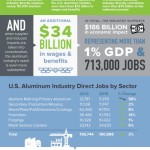Aluminum is not only one of the most sustainable materials these days, it is also making headlines – most recently during the North American Leaders Summit, also dubbed “Three Amigos Summit” held at the end of June in Ottawa, Canada. Invoking challenges associated with China’s trade policy, President Obama called for the North American countries to work together to “ensure a level playing field for the steel and aluminum industries here in North America.”
The stakes are high, and with demand on the rise for durable, lightweight and sustainable materials, the Aluminum industry’s contribution to the U.S. economy — and with that, to the renaissance of U.S. manufacturing — is significant.
And that significance is measurable. According to an April 2016 study conducted by economic research firm John Dunham & Associates, the U.S. aluminum industry provides 161,000 direct jobs, and accounts for nearly 551,000 additional jobs created through multiplier effects. Expressed in dollar figures, that means the U.S. aluminum industry’s direct contribution to the U.S. economy has reached $75 billion. When accounting for induced impacts, that number shoots up to $186 billion — more than one percent of national GDP. The Aluminum Association has a great infographic on this:
While the U.S. is home to significant bauxite deposits, from which aluminum is sourced, we import a significant percentage of the aluminum consumed domestically. Unlike with other metals and minerals, this represents a marked decrease in geopolitical risk, as most of our aluminum imports are sourced from one of our closest trading partners, Canada. In fact, in 2015, Canadian-sourced imports accounted for 65% of crude aluminum, 21% of semimanufactures, 64% of scrap, and 54% of total aluminum imports.
In other words, viewed in isolation and from the upstream end of the supply chain at the minesite, the U.S. is increasingly import-dependent for the aluminum it needs. But in the context of an integrated North American supply chain between the two trading partners, a look at USGS’s 2014 Minerals Yearbook reveals that Canada is helping the U.S. close a 3.4 million ton domestic aluminum production shortfall by supplying more than 2.2 million tons of crude ingot and 227,000 tons of semifabricated aluminum.
The geopolitics of resource supply are complex and constantly changing. Trade gives us a more complete picture — but the fundamental fact remains that in our tech-dependent era, manufacturing might is rooted in reliable resource supply.





